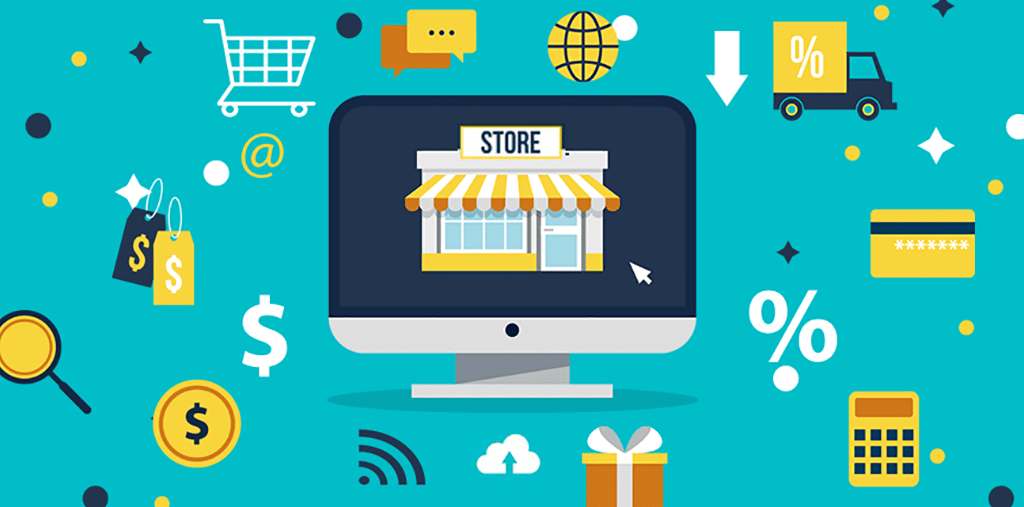
Words are powerful. Just one change in your business category and you will be perceived differently. That’s why it is crucial for you to try and work towards building a brand and not just an eCommerce store. A ‘brand’ is considered more trustworthy and reliable than just another online shop.
When someone said, what’s in a name, that was not meant for an eCommerce store. Today, in a world that is powered by social media, it is crucial to make a name for yourself; a brand for yourself. Something that your customers can show off. Just having an eCommerce store that sells shoes or homeware is certainly not enough.
You need to put in your time and effort to take your brand from the bottom to the top ranks.
Branding is not just a one-time process, it is ongoing. It helps you distinguish yourself from others in the crowd and give your store an identity of its own. It also enables your audience to understand that it’s you from afar.
Another reason why brand-building should be on your cards is to help you with eCommerce SEO. Let me tell you why.
Just like you would pick Coca-Cola over any other cola brand in your local grocery store, you would also choose to click a link of brands that you recognize, irrespective of the fact that the other link is ranked number one on the SERPs. It’s a habit. You cannot really help it.
This is why you need branding; to make your customers recognize your brand and to make them habitual of it. Now, before we go ahead with why and how you can build a brand around your eCommerce store, let’s just understand what branding means and what all it includes.
What is branding?

Branding is a feeling.
It is a strategy that defines and directs your store’s emotions, meaning, and consumer perception. Branding helps you create and shape a specific image of your eCommerce store in the minds of your consumers. It distinguishes your business from the others in the market.
Branding is powerful in terms of pushing your brand to the top when your customers are in the consideration stage. This means that if you have a strong brand-building approach, the chances of your store being the top choice for your customers are pretty high.
We have already talked about how social media has changed the meaning of shopping. Today, people dress up to show to the world. This makes it important for them to wear brands that are recognized.
The best way to make your brand recognized is by working on your branding.
So, what all is included in branding? Here’s a checklist to make it a little easier for you to understand.
– Design elements (logo, color palette, typography)
– Style elements (visual appeal, compositions, graphics, videos, and audios)
– Essence elements (mission, vision, emotions, values, traits, expectations)
So, if you see, it’s not just your logo or your color palette that defines your brand. It is also your messaging, your ideologies, and your ethics among many other factors. Still not sure why you need to adopt brand building for your eCommerce store? Let me break it down for you.
Why should you work on brand building for your eCommerce store?

Here are a few answers to your big ‘BUT WHY’.
1. Helps improve SEO
SEO is perhaps one of the most important strategies to make your brand rank on top of the SERPs. The better you rank, the more visibility you get.
With the right branding practices, you can give your SEO strategies a boost.
When your prospective audience searches for key phrases that are related to your industry or your brand on the search engines, they will be spoilt for choice. There are thousands and thousands of other brands that are probably selling products similar to yours.
So, what exactly helps your customers make the decision of what links they should click on and what links they shouldn’t?
It’s brand recognition.
If your customers know your brand or have heard of it even once, they will visit your website and drive higher click-through rates.
You can always take help from professionals that offer SEO services to ensure you are not missing out on your customers. Every time your website is not getting enough click-through rates, it is missing out.
So, you see, digital marketing runs on branding.
2. Makes your brand recognizable
When you see an ‘A’ with a golden arrow, you know it’s Amazon; when you see the colors red and white, you know it’s Coca-Cola. How? It’s because these brands have repeatedly worked on their branding.
As a result, the smallest of the elements have made them recognizable from far off.
Let us take Coca-Cola’s example.
Coca-Cola is now used as a synonym for ‘Happiness and Sharing’. How? Because of the stories that they have been sharing in their advertising campaigns for hundreds of years now. Every commercial you see ends with an iconically shaped bottle of Coca-Cola.
From photographs to videos, from ad graphics to the basic concepts, everything is coherent. And it has been this way since the 1800s. If you’ve noticed, you’ll always find Coca-Cola commercials filled with actors laughing and chatting. This is the essence they’ve always wanted to share and have managed to do exactly that.
That’s why, even if you don’t watch the ad completely or if Coca-Cola leaves out their logo in the red and white print ads, you will still know it’s Coca-Cola. That’s the power of branding.
3. Shows you are organized

When you have your branding in place, you showcase that you are organized and consistent with your efforts. After all, it takes years and years of discipline to align all your marketing practices around certain themes, colors, and ideologies.
Imagine you have to attend a meeting and you see the other person showing up messy. It will change your impression of that person. But had they been well-dressed and well-groomed, they would have had a completely different perception of you.
When you show consistency, it helps your customers understand that you are put together. It makes your brand seem more competent. This induces trust among your audience and helps them make a decision of choosing you over others.
4. Builds emotional connection
Branding is all about emotions. It’s about how a customer feels and what they think about when they hear your name. From your services to your colors, a lot can play out on these emotions.
When you brand your store right, it can help you gain your customer’s trust. It can also help you gain brand loyalty. This means that you improve your chances to make more sales with your existing customers.
Moreover, when you evoke such positive feelings among your audience, it makes them feel comfortable. This in turn allows them to build emotional connections with your brand which keeps them around for much longer than how much you might have anticipated.
This is why you should be working on building a brand around your eCommerce store. I know it can get a little daunting but that’s why I am here. Below are a few actionable practices that you can use to turn your eCommerce store into a brand.
What are the best practices to turn your store into a brand?

Just want to put a tiny disclaimer here. These practices given below have worked for brands but you should keep in mind that there is no one-size-fits-all when it comes to branding. You should always mold these below-mentioned practices according to your brand, do some trial and error, and then work on what’s high-yielding for you.
1. Conduct a market research
This is perhaps the most basic practice that’s not only needed for branding, but for running your business smoothly as well.
Market research is identifying your competitors and analyzing their branding process. From leading names to those who have only just stepped into the market, you should research them all.
To identify your competitors, you can check out the search engine results and see who’s ranking on the top. Alternatively, you can observe the brands that your target customers are using or talking about (you can use social listening tools for the same).
Once identified, do a SWOT analysis where you are covering their brand positioning, strategies for sales, content, pricing, marketing, and promotions. Also, do not miss out on checking out their website.
One thing you should definitely analyze thoroughly is their social media account. See the kind of posts they are uploading and how it is being perceived, check their engagement rates, try to understand their campaigns, and also, find out how frequently they publish.
When you are done with your market research, you will fairly have an idea about the direction that you should be taking. You can keep that as one of your options and only finalize once you are starting out.
2. Identify your target audience
Now that you have taken a look at one side of the coin, it’s now time to take a look at the other. This means that you must now observe your audience.
Yes, it can get a little tricky, but it is not impossible to do that. Also, it’s an indispensable step because if you don’t know who your audience is, you won’t know who you should create products for or sell to.
Thus, it’s always best to know who your audience is and where it is located.
To do this, you can start by creating yourself a buyer’s persona. A buyer’s persona is basically an assumption about your target audience. It might include:
- Name
- Demographics (Age, Gender, Location)
- Tastes
- Hobbies
- Challenges
- Income
- Occupation
Of course, you have an option to add or omit more factors. But this is a very basic buyer’s persona that you should create in the initial stages of your branding.
This will help you understand whether your audience is young or old. If it’s young, you can keep your colors and message bold and modern, but if it’s old, you will be required to embrace light colors and avoid any slang used by the generation today.
This is why identifying your target audience is important.
3. Embrace the art of storytelling
Storytelling is what many eCommerce stores overlook, and it leads to their failure.
Your customers are human beings, and you must keep this fact in your mind at all times. This means that emotions play a significant role when you are strategizing your branding. You can leverage storytelling for exactly that.
Use this art to tell your customers your background or your brand story.
Your customers love it when they hear how your brand came to be, what inspired you to start your online store, your struggles, your successes, and even your failures. When you tell them your story, it makes it easy for them to connect with you.
You don’t seem like just any other brand then. You are perceived as a brand that rose from the ashes or a brand that recognizes its struggles. They give you a face. They think of you as that individual that they know the name of but don’t really remember how the individual looks like.
Thus, when you are building a brand, embrace the emotions as tightly as you can.
You can share your brand story as your social media posts or maybe even add to the ‘About Us’ section on your website.
4. Make it meaningful
When you are branding yourself or talking about your product, you are telling your customers what they can depend on. You give a commitment to your customers that you can take care of their needs and offer them a reliable solution.
After this commitment comes an attempt to offer a positive experience to your customers at all times.
Now, your branding shouldn’t just focus on telling your customers that you offer premium quality or ‘world-class services’. When you say you are a world leader, you are not fooling anyone. Instead of actually looking like leaders, you will be perceived as quite the opposite. Why? Because everybody is already saying that about themselves.
Your main focus should not be on telling people that you offer a great experience, instead, it should be to show them that you do.
Here’s how you can show it.
Do not talk about your brand in a business-centric approach. Keep your customers at the center of your strategy.
Have a conversation with your customers either using your social media or maybe by getting a form filled in where you ask them about what they value the most about your brand or how you can improve.
When you communicate with your audience directly, it helps give you a clear brand strategy; something that will help you stand out from others.
5. Offer a solution, not just a product
Most eCommerce stores, especially when they are just starting out, simply offer a product that they think the customers want. They don’t bother to understand the actual market needs. This is a recipe for failure.
What you should actually be doing is understanding the challenges your customers are facing. Help them realize that your product is simply the perfect and the missing solution for that challenge.
Show them the benefits they can reap by using your product over that of others. You can do this by sharing product videos, customer testimonials, or reviews.
You can also leverage creating personal bonds and relationships with your customers. Empathize with your audience and genuinely serve them the right solutions for their needs/grievances.
This is certainly advantageous for you and your customers both.
6. Engage in conversations
Of course, you don’t really have complete control over the conversations that take place between you and your customers. However, you do have an option to guide that conversation to a stage where you are responding to the needs of your customers.
This will help you give a competitive advantage.
You can engage in a conversation with your customers either by giving them a call, writing them an email, or maybe by using other virtual ways. You can use this communication to request feedback.
Today, social media gives you information that you can leverage. You can understand if you are succeeding in wooing your customers or if something is backfiring; you’ll know what is being liked by them and what is not.
You can also find opportunities to build a community or strengthen bonds with your customers using this information.
There are plenty of social listening tools that you can use to find conversations that mention you. If your customers are leaving negative comments, address their problems. This will showcase you as a brand that cares and that’s something you should definitely leverage.
7. Make your position clear
The above-mentioned feedback that you get from your social listening tools is a great way to understand where your strength lies. You can further strategize how you can use this to become a preferred eCommerce store for your target audience.
Such feedback also has hidden pointers on how you can add more value to the lives of your customers that will make them more reliant and loyal towards your brand.
Gone are the days when branding revolved around pricing. Your customers will not really care about your store even if you are selling the products at cheaper rates. Similarly, faster delivery or being the ‘latest’ product in the market wouldn’t change a thing. They’re all old school.
What you should be focusing on instead of these is how your product or your brand can help your customers meet their goals. Your product should be a solution to the challenges your customers are facing.
If you are selling customized shoes for flat feet, your brand should revolve around this specialty. It shouldn’t be about how you are selling these shoes at rates that are lower than others in the market.
Brand your product as a solution provider and not as someone that offers fast delivery or lower rates. This is because, towards the end, it’s not about how you can physically differentiate your brand from others. Instead, it’s about how your audience feels and perceives your brand differently.
8. Every member matters
Your aim should be to include each and every member of your eCommerce store in working towards building the brand out of your eCommerce store.
Branding is all about consistency, transparency, and authenticity. That’s why each and every member of your store should play some role or the other in helping you shape your brand. It is only after that will you be able to reach that level.
One thing you definitely need to do is educate your employees about the same.
In fact, when you are recruiting, make brand awareness your requirement. Let your candidates know that having a thorough understanding of your brand and its meaning will be your criteria for awarding them with bonuses or promotions. Let them know how crucial your brand image is.
Also, you should make an effort to ensure all forms of media that your employees are creating, and sharing have consistency in them. They should share your brand message in the same tone and visual appeal. It will help make your brand look more organized.
9. Keep the consistency alive
Consistency is the key to success. This is especially true with regards to branding.
When you are trying to turn your regular eCommerce store into a brand, your messaging should align with your service or your product and vice versa. This consistency and alignment are what will help you attract and maintain your customer’s trust and loyalty. These are perhaps the two of the most important pillars for any marketing strategy to work.
Let me give you an example.
Suppose you are a brand that promotes sustainable products. Now, being a brand that’s environment friendly, you need to ensure that your packaging material and even your shipping material are environment friendly.
Apart from your products, you should also promote practices that protect the environment. You can ask your employees to carry their own bottles instead of buying plastic ones.
Also, if you are a brand that promotes itself as a solution and wishes to just make its customers happy and genuinely work towards making their lives easy, avoid the .99 strategy. If your product costs $40, keep it $40 and not $39.99.
These small practices will help you align your marketing strategies not only with your product but also with your vision and your goal. It will showcase your beliefs instead of just them reading about them.
This helps attract customers and also keep them around for longer because they feel they are being valued.
10 .Cover the basics
There are certain basics of branding that you should be taking care of. These are basically a few things that should be prepared in the initial stages of the process. These elements are used by almost all brands. And the basics that you need to work on include:
- Logo
- Color Palette
- Typography
- Iconography
- Logo Usage
- Design Systems
- Photography
- Videography
- Illustration Designs
- App Design
- Interactive Elements
- Web Design
These are a few basic elements that you must cover under your branding efforts. These are basically all the elements that your brand identity comprises. But keep in mind that you can always add or omit elements that are not relevant to you or your brand.
Conclusion
To wrap it up, we can say that turning your eCommerce store into a brand takes effort and time. Your ‘brand’ is just not about how your logo will look or what colors should be a part of your palette. It mainly includes your beliefs, your goals, and the perception your customers have of you.
One thing that can help build a positive reputation is consistency. Show consistency not only in your visual campaigns but also in every other aspect of your business. Ensure consistency in your packaging, your shipping, and your messaging, but also in your real-life practices. This helps your customers understand you are an organized brand. This consequently helps you build a credible brand.
The branding process might seem a little daunting initially, but it’s worth every second spent.

